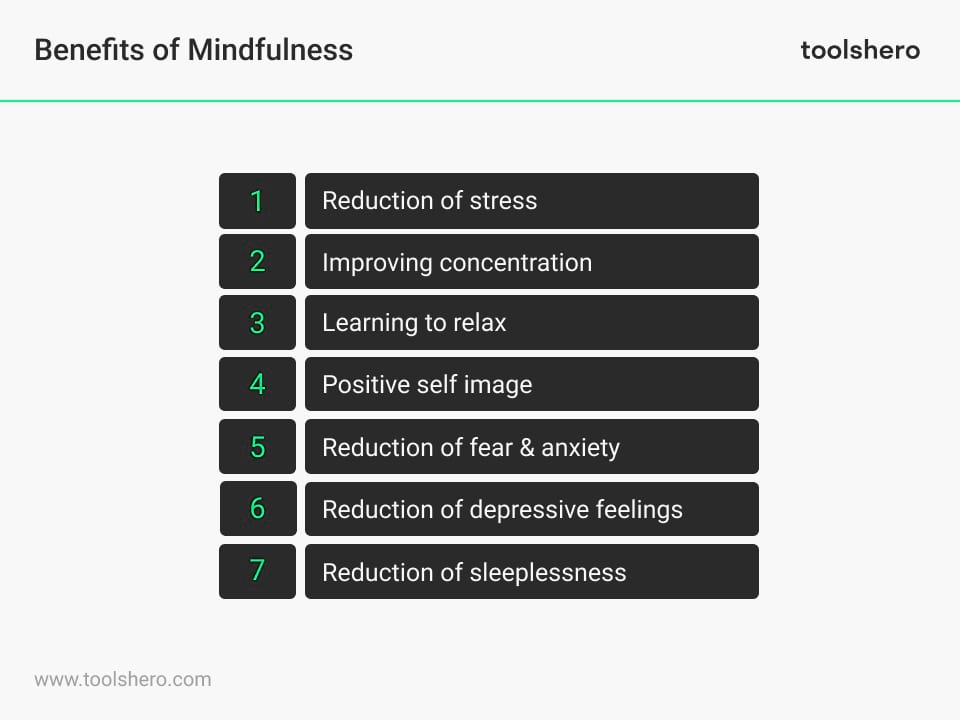Mindfulness: the meaning and principles

Mindfulness: this article describes the concept of Mindfulness in a practical way. After reading you will understand the basic principles of this powerful personal happiness philosophy. This article covers its meaning, origins, benefits and practical tips. Enjoy reading!
Background of Mindfulness
Vipassana is a Buddhist attention training that aims to bring people into an experience of present existence, as it really is. This has been applied in Buddhism for 2,000 years as a specific Buddhist meditation technique.
In the Western medical and / or psychotherapeutic context, mindfulness became known through American researcher Jon Kabat-Zinn, molecular biologist and founder of the Stress Reduction Clinic at the University of Massachusetts.
He derived the term mindfulness from the Vietnam monk, Thich Nhat Hanh, who was banned from his country of origin during the Vietnam War and lived in France, among other places. He trained others in the training of attention according to Buddhist teachings in the sixties.
Many other Buddhist monks also taught Vipassana in its pure form, which eventually led to many Western practitioners, of what was later called mindfulness. Nowadays, mindfulness is used in, among other things, Mindfulness Based Stress Reduction Program (MBSR), and Mindfulness Based Cognitive Therapy (MBCT).
With this practice, you learn to bring your attention to the present moment
Mindfulness practices can help alleviate symptoms of anxiety and depression.
The key to mindfulness is paying attention to what’s happening inside and around you.
Conscious attention
The definition and meaning
Mindfulness means giving conscious attention to this moment and being aware and perceptive without judgement. Despite it being derived from the Eastern Buddhism, mindfulness is used in Western psychotherapy where stress reduction is central.
This philosophy has been shown to be an effective instrument to combat stress. Through this tool, people who experience a high degree of stress due to, for example, a burn-out, learn how to better deal with stress.
This philosophy is being fully present with full attention to the moment. Not thinking too much about the past or the future. It is about the here and now. Through mindfulness, one learns to deal with stress and tension, which can lead to worrying about the future.
Some key elements of this method are:
- Present moment: It means focusing on what’s happening right now
- Mind wanders: During the execution of meditation, our thoughts often drift away, but we learn to bring them back gently
- Mental health: Mindfulness helps improve how we feel in our minds
- Thoughts and feelings: We watch our thoughts and feelings without judgment when we practice mindfulness
- Everyday life: Mindfulness is useful in our daily routines
- Regular practice: Doing mindfulness regularly is important for its benefits
Mindfulness is acceptance
Although this philosophy has its roots in Buddhism, practitioners don’t necessarily have to have knowledge of Buddhism, Vipassana, Yoga or other meditation techniques.
One of the most important elements is to reach acceptance. In the West, people are very much driven by the things they need and what is expected of them. With this philosophy one learns to accept that certain things in life can not be controlled and that it is not necessary to constantly be in control.
It’s mainly about learning to deal with situations that you are not able to control. Mindfulness is therefore the state of mind that is typified by the awareness of one’s own physical experiences, feelings and thoughts without immediately giving in to automatic responses.
To work towards full mindfulness, one follows training, meditation and other attention exercises.
Characteristics of Mindfulness
This philosophy refers, on the one hand, to training in which one learns to live more consciously and to deal with stressful thoughts and emotions.
On the other hand, it is a form of meditation, in which one becomes aware of the physical and mental sensation and situation of the moment in a non-reactive manner. The conscious attention is central to this.
More features of this philosophy include:
- Being present in the here and now
- Observation without judgement
- Acceptance of what is
Mindfulness has all of the above ingredients. One learns to live with their own human unrest, including irritation, impatience, frustration, anger and sorrow. Through mindfulness one learns how to cope with everything that leads to unrest.
The Complete Mindfulness Course – Enjoy Life In the Present
The benefits of Mindfulness
Mindfulness is often offered in training sessions and helps people get rid of stress, learn better how to handle stress, become more focused and happier, enjoy more, work more effectively and sleep better.
These are a number of topics that lead to complaint reductions. In addition, mindfulness training also results in the following:
- Reducing stress and therefore better dealing with stressful situations
- Improving concentration and performance
- Being able to relax
- Positive self image
- Reduction of fear and anxiety
- Reduction of feelings of depression
- Reduction of sleeplessness
Due to this philosophy, a shift in brain activity takes place from the left to the frontal cortex, which results in less fear. People who have had a depression more than three times in their life have a 50% less chance of relapse after following a mindfulness training.

Figure 1 – Benefits of Mindfulness
Practice and tips
A mindfulness training deals with some theory in combination with (meditation) exercises. After the training, candidates receive a lot of exercises that they can use at home, including meditation exercises.
Practice makes perfect and in order to achieve the right mindset it is important to practice daily. Through mindfulness one learns to see things as they really are.
The exercises concern perceiving, giving attention, not judging and accepting.
It’s Your Turn
What do you think? Is Mindfulness applicable in your daily life? Do you recognize the practical explanation or do you have more suggestions? What are your success factors for being focused, have inner peace and have a low stress level?
Share your experience and knowledge in the comments box below.
More information
- Brown, K. W., & Ryan, R. M. (2003). The benefits of being present: mindfulness and its role in psychological well-being. Journal of personality and social psychology, 84(4), 822.
- Langer, E. J. (1989). Mindfulness. Addison-Wesley.
- Morgan, D. (2003). Mindfulness-based cognitive therapy for depression: A new approach to preventing relapse.
- Walker, T.J. et al. (2023). The Complete Mindfulness Course – Enjoy Life In the Present. Retrieved 03/19/2024 from Udemy.
How to cite this article:
Mulder, P. (2017). Mindfulness. Retrieved [insert date] from Toolshero: https://www.toolshero.com/psychology/mindfulness/
Original publication date: 12/28/2017 | Last update: 03/19/2024
Add a link to this page on your website:
<a href=”https://www.toolshero.com/psychology/mindfulness/”>Toolshero: Mindfulness</a>












